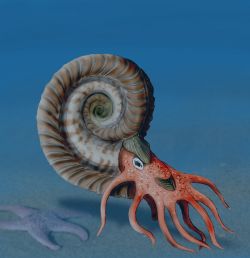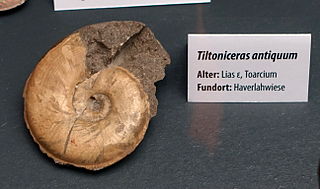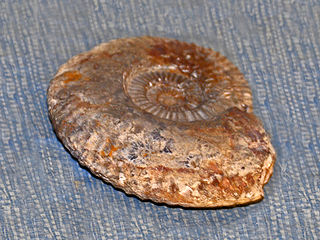Haplopleuroceras is a Middle Jurassic ammonite and likely member of the Hildoceratacean family Sonniniidae with which it shares the same sort of ribbing.

The Trigonoceratoidea are a superfamily within the Nautilida that ranged from the Devonian to the Triassic, thought to have contained the source for the Nautilaceae in which Nautilus is found.

Grypoceratidae is the longest-lived family of the Trigonoceratoidea, or of the near equivalent Centroceratina; members of the Nautilida from the Upper Paleozoic and Triassic.
The Centroceratidae is the ancestral family of the Trigonoceratoidea and of the equivalent Centroceratina; extinct shelled cephalopods belonging to the order Nautilida

Oxynoticeratidae is a family of true ammonites included in the superfamily Psiloceratoidea.

Amaltheidae is a family of eoderoceratoidean ammonitids from the Lower Jurassic consisting of genera characterised by stigated discoidal oxycones—narrow involute shells with narrowly rounded to angular venters that bear a series of grooves, or ridges, along broad flanks, which according to the Treatise L, 1957, evolved into strongly ribbed planulates with quadrate whorls, typically with crenulated keels; involving all together four genera.

Lytoceratidae is a taxonomic family of ammonoid cephalopods belonging to the suborder Lytoceratina, characterized by very evolute shells that generally enlarge rapidly, having whorls in contact but mostly overlapping very sightly, or not at all.
Brancoceratidae is a family of acanthoceratoid ammonites from the middle of the Cretaceous, recognized by their commonly evolute shells with round, oval, or quadrate whorls, strong ribs, usual ventral keels, and at least, umblical tubercles. The family is thought to be derived from the Desmoceratidae (Desmoceratoidea), perhaps from Silesitoides or some allied genus.

The family Dactylioceratidae comprises Early Jurassic ammonite genera with ribbed and commonly tuberculate shells that resembled later Middle Jurassic stephanoceratids and Upper Jurassic perisphinctids. Shells may be either evolute or involute.

Echioceratidae is an extinct family of ammonites that lived during Sinemurian stage of Early Jurassic.

Harpoceras is an extinct genus of cephalopod belonging to the family Hildoceratidae. These cephalopods existed in the Jurassic period, during Toarcian age from Falciferum zone to Commune subzone of Bifrons zone. They were fast-moving nektonic carnivores.
Ovaticeras is an extinct genus of cephalopod belonging to the family Hildoceratidae. These cephalopods existed in the Jurassic period, during upper Pliensbachian and lower Toarcian. Its fossils were found in Europe, North Africa and possibly also in Canada and Vietnam. It might have evolved from Harpoceras falciferum and died out without leaving any descendants.

Cleviceras is an extinct genus of cephalopod belonging to the family Hildoceratidae. These cephalopods existed in the Jurassic period, during Toarcian and possibly even uppermost Pliensbachian age. Sometimes, it is considered to be a synonym of Eleganticeras.
Radstockiceras is an extinct genus of lower Jurassic ammonite that lived from Oxynotum zone of upper Sinemurian to Raricostatum zone of lower Pliensbachian. Shells of these animals were oxycone and involute with umbilicus that took maximum of 12% of diameter in the case of outer whorls. On inner whorls, venter has been sharp, but then it became rounded. Faint ribs had falcoid shape, but sometimes, ribs could absent. Shells could have been large in their size. Suture has been very complex, similar to Oxynoticeras, but culmination at umbilical margin has been missing. Genus has been named after town of Radstock, in Somerset.
Paroxynoticeras is an extinct genus of lower Jurassic ammonite that lived during upper Sinemurian. Animals belonging to this genus had platyconic shells with compressed whorl section and could grow to large sizes. In the case of young specimens, umbilicum is small, but it increases in bigger specimens.. Last whorl is excentric, which can occur also in relative species, Paracymbites. While on the outer whorls, venter is always rounded, on inner whorls it can be both rounded or sharp. Ornamentation on inner whorls and suture is similar to Oxynoticeras, but in bigger specimens, ribs became straight, simple and blunt. In these bigger specimens, midlateral tubercules might be present.
Slatterites is an extinct genus of lower Jurassic ammonite that lived during upper Sinemurian. Animals belonging to this genus had small shells that had oxycone whorl section and sharp venter when young. In the case of older specimens, whorl section becomes oval and venter is round. This change is very quick. Last whorl is decorated by blunt ribs that can be alternating on opposite sides. Suture is by broad and simple elements similar to suture of Eparietites.
Cymbitidae is family of ammonite that lived during Sinemurian and Pliensbachian stages of Lower Jurassic. They have probably evolved from Arietitidae.
Reynesocoeloceras is genus of ammonite that lived during the lower Pliensbachian stage of early Jurassic, ammonite zones Ibex—Davoei.

Hildoceratinae is an extinct subfamily of cephalopods belonging to the family Hildoceratidae. Ammonites of this subfamily had shells with elliptical or quadrate whorl section with keel or tricarinate, bisulcate venter. Ribs were variable, from falcate to strongly angled and from fine to strong. They can be interrupted by spiral groove in midlateral part of the shell. While some species can be smooth, strongly ribbed ones can have tubercules. Microconchs have short lapplets that is in its shape similar to the shape of growth lines in spiral midlateral groove.

Tiltoniceras is an extinct genus of cephalopod belonging to the family Hildoceratidae. These cephalopods existed in the Jurassic period, from upper Pliensbachian age, Spinatum zone until lower Toarcian, Tenuicostatum zone in what is now Europe, North America and Asian part of Russia.

















